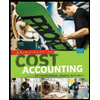
Concept explainers
What is a relevant cost?
Determination of relevant cost describes the concept of relevant concept in decision making. The relevant cost is the cost which has the impact of change with the implementation of decision.
To Discuss:
The concept of relevant cost
Answer to Problem 1Q
Solution:
The relevant cost is the cost which has a behavior of change with the change in decision in making. It refers to incremental cash outflows to be incurred as a result of decision implementation, opportunity cost to be foregone for implementing the decision and the cost avoided with the implementation of decision.
Explanation of Solution
The Relevant cost in the decision making is a cost which has the relevance while taking up the decision. These are referred as all those cost which has the impact of change (whether increase or decrease) with the implementation of decisions taken. These are referred as following cost:
- Cash outflows need to be undertaken for implementing any project/ decision is the relevant cost for the project/ decision.
- If the decision is to choose between the alternatives, then the relevant is the incremental cost to be incurred in a particular alternative than the cost incurred in other alternative.
- The Relevant cost also includes the opportunity cost of the next best alternative. The opportunity cost is the amount of revenue/ income generated from present project, which has to be sacrificed for undertaking the new opportunity.
- The relevant cost is the cost which can be avoided if the decisions taken.
To conclude, it can be said that the relevant cost is the cost which changes with the decision making and measuring these cost will have an impact on decision making.
Want to see more full solutions like this?
Chapter 11 Solutions
Introduction to Managerial Accounting - Connect Access
- Can you help me solve this general accounting question using the correct accounting procedures?arrow_forwardHorngren's Financial & Managerial Accounting: The Managerial Chapters, 8th Edition. E-M:9-14 Describing the balanced scorecard and identifying key performance indicators for each perspectiveConsider the following key performance indicators and classify each indicator according to the balanced scorecard perspective it addresses. Choose from the financial perspective, customer perspective, internal business perspective, and the learning and growth perspective. a.Number of customer complaintsb.Number of information system upgrades completedc.Residual incomed.New product development timee.Employee turnover ratef.Percentage of products with online help manualsg.Customer retentionh.Percentage of compensation based on performancei.Percentage of orders filled each weekj.Gross margin growthk.Number of new patentsl.Employee satisfaction ratingsm.Manufacturing cycle time (average length of production process)n.Earnings growtho.Average machine setup timep.Number of new customersq.Employee…arrow_forwardDo fast answer of this general accounting questionarrow_forward
 Principles of Cost AccountingAccountingISBN:9781305087408Author:Edward J. Vanderbeck, Maria R. MitchellPublisher:Cengage Learning
Principles of Cost AccountingAccountingISBN:9781305087408Author:Edward J. Vanderbeck, Maria R. MitchellPublisher:Cengage Learning Managerial Accounting: The Cornerstone of Busines...AccountingISBN:9781337115773Author:Maryanne M. Mowen, Don R. Hansen, Dan L. HeitgerPublisher:Cengage Learning
Managerial Accounting: The Cornerstone of Busines...AccountingISBN:9781337115773Author:Maryanne M. Mowen, Don R. Hansen, Dan L. HeitgerPublisher:Cengage Learning Cornerstones of Cost Management (Cornerstones Ser...AccountingISBN:9781305970663Author:Don R. Hansen, Maryanne M. MowenPublisher:Cengage Learning
Cornerstones of Cost Management (Cornerstones Ser...AccountingISBN:9781305970663Author:Don R. Hansen, Maryanne M. MowenPublisher:Cengage Learning- Principles of Accounting Volume 2AccountingISBN:9781947172609Author:OpenStaxPublisher:OpenStax College
 Survey of Accounting (Accounting I)AccountingISBN:9781305961883Author:Carl WarrenPublisher:Cengage Learning
Survey of Accounting (Accounting I)AccountingISBN:9781305961883Author:Carl WarrenPublisher:Cengage Learning Managerial AccountingAccountingISBN:9781337912020Author:Carl Warren, Ph.d. Cma William B. TaylerPublisher:South-Western College Pub
Managerial AccountingAccountingISBN:9781337912020Author:Carl Warren, Ph.d. Cma William B. TaylerPublisher:South-Western College Pub





